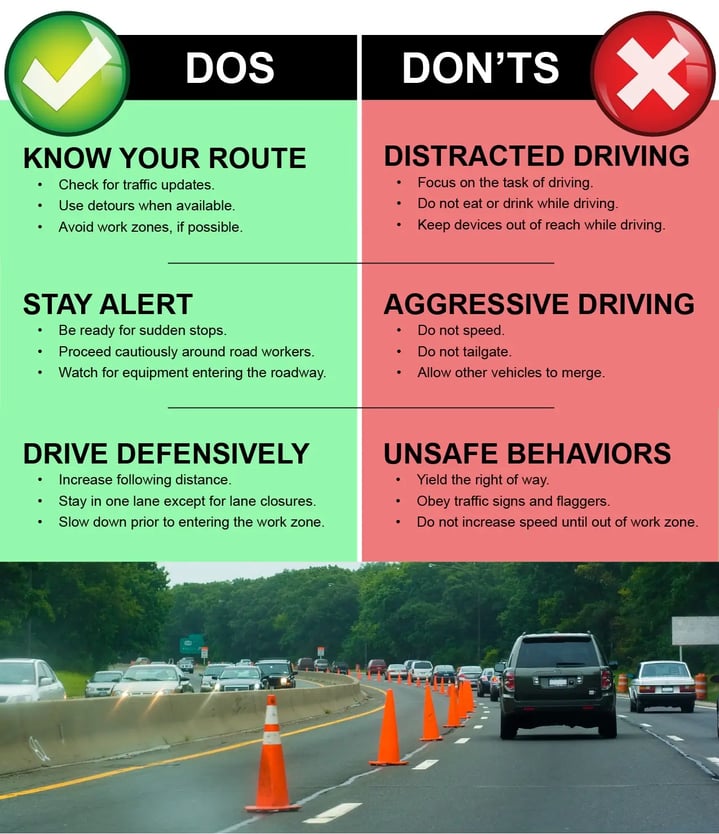Work Zone Loss Prevention Techniques
No matter what time of year it is, there is no escaping the orange work zone barrels and cones. Work zones are essential to maintaining and upgrading our nation’s highways, but they may also represent an operational risk to motor carriers. Daily changes in traffic patterns, narrowed rights of way, and other construction activities can play a factor in commercial motor vehicle-related incidents in and around work zones. According to the National Highway Transportation Safety Administration (NHTSA), “Fatal work zone crashes involving commercial motor vehicles increased significantly in 2021—from 210 fatal crashes in 2020 to 291 fatal crashes in 2021. This 39-percent increase is in stark contrast to the 2-percent increase in fatal work zone crashes not involving a large truck or bus.”
In addition to serious injuries and fatalities, a work zone-related incident can create excessive delays. Even if a motor carrier’s driver is not directly involved in an incident, when roads are closed for emergency services and cleanup, the resulting delays create business interruptions that may result in financial losses such as late deliveries and increased fuel consumption. To help prevent these types of losses, consider the following loss prevention techniques and discuss them with your drivers and operations staff.
LOSS PREVENTION TECHNIQUES FOR DRIVERS
-
KNOW THE ROUTE
Remind drivers to plan their routes in advance and monitor traffic reports periodically for road closures and delays.
-
DRIVE DEFENSIVELY
Remind drivers to slow down in work zones and to yield the right of way to merging vehicles.
-
AVOID DISTRACTIONS
Remind drivers to be attentive and focus on the task of driving. Drivers should watch for workers and equipment in the work zone and avoid distractions like mobile devices.
-
OBEY TRAFFIC SIGNS
Remind drivers to obey all traffic signs and flaggers in and around the work zone.
LOSS PREVENTION TECHNIQUES FOR DISPATCHERS
-
ROUTING
Remind dispatchers to monitor traffic reports and route drivers away from work zones.
-
COURTESY CALLS
Remind dispatchers to call shippers and receivers on behalf of the driver and inform them of anticipated delays.
-
INSPECTIONS
Instruct dispatchers to remind divers daily to conduct pre-trip vehicle inspections. Keeping the mirrors properly aligned and windows clear can increase the driver's visibility.
-
SUPPORT
Work zone delays can be frustrating for drivers. Remind dispatchers not to add to their stress by calling the driver and creating a distraction. Instead, have dispatchers wait until the driver's designated call-in time and be a good listener.
*Source: FHWA Work Zone Facts and Statistics. https://ops.fhwa.dot.gov/wz/resources/facts_stats.htm
Work Zones
Commercial motor vehicles have limited maneuverability and large blind spots, features which can make navigating work zones a challenge. However, practicing safe driving techniques may help reduce the risk of an accident. Read the suggested Do’s and Don’ts below related to driving in work zones and ask yourself how you can improve your driving.

CALL TO ACTION
- Distribute the Work Zones article in this edition of Safety Talk to drivers.
- Discuss the loss prevention techniques for dispatchers with your team.
- Train drivers on pre-trip inspections and proper mirror alignment.
The information in this article is provided as a courtesy of Great West Casualty Company and is part of the Value-Driven® Company program. Value-Driven Company was created to help educate and inform insureds so they can make better decisions, build a culture that values safety, and manage risk more effectively. To see what additional resources Great West Casualty Company can provide for its insureds, please contact your safety representative, or click below to find an agent.
© Great West Casualty Company 2023. The material in this publication is the property of Great West Casualty Company unless otherwise noted and may not be reproduced without its written consent by any person other than a current insured of Great West Casualty Company for business purposes. Insured should attribute use as follows: “© Great West Casualty Company 2018. Used with permission by Great West Casualty Company.”
This material is intended to be a broad overview of the subject matter and is provided for informational purposes only. Great West Casualty Company does not provide legal advice to its insureds, nor does it advise insureds on employment-related issues. Therefore, the subject matter is not intended to serve as legal or employment advice for any issue(s) that may arise in the operations of its insureds. Legal advice should always be sought from the insured’s legal counsel. Great West Casualty Company shall have neither liability nor responsibility to any person or entity with respect to any loss, action, or inaction alleged to be caused directly or indirectly as a result of the information contained herein.




